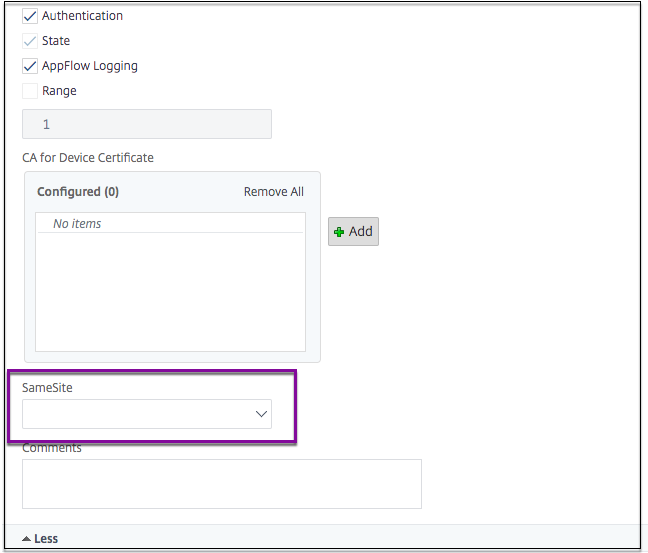-
Basic components of authentication, authorization, and auditing configuration
-
-
On-premises Citrix Gateway as an identity provider to Citrix Cloud
-
Configuration support for SameSite cookie attribute
-
Authentication, authorization, and auditing with commonly used protocols
-
Troubleshoot authentication and authorization related issues
This content has been machine translated dynamically.
Dieser Inhalt ist eine maschinelle Übersetzung, die dynamisch erstellt wurde. (Haftungsausschluss)
Cet article a été traduit automatiquement de manière dynamique. (Clause de non responsabilité)
Este artículo lo ha traducido una máquina de forma dinámica. (Aviso legal)
此内容已经过机器动态翻译。 放弃
このコンテンツは動的に機械翻訳されています。免責事項
이 콘텐츠는 동적으로 기계 번역되었습니다. 책임 부인
Este texto foi traduzido automaticamente. (Aviso legal)
Questo contenuto è stato tradotto dinamicamente con traduzione automatica.(Esclusione di responsabilità))
This article has been machine translated.
Dieser Artikel wurde maschinell übersetzt. (Haftungsausschluss)
Ce article a été traduit automatiquement. (Clause de non responsabilité)
Este artículo ha sido traducido automáticamente. (Aviso legal)
この記事は機械翻訳されています.免責事項
이 기사는 기계 번역되었습니다.책임 부인
Este artigo foi traduzido automaticamente.(Aviso legal)
这篇文章已经过机器翻译.放弃
Questo articolo è stato tradotto automaticamente.(Esclusione di responsabilità))
Translation failed!
Configuration support for SameSite cookie attribute
The SameSite attribute indicates the browser whether the cookie can be used for cross-site context or only for same-site context. Also, if an application intends to be accessed in a cross-site context then it can do so only via the HTTPS connection. For details, see RFC6265.
Until Feb 2020, the SameSite attribute was not explicitly set in Citrix ADC. The browser took the default value (None). Not setting the SameSite attribute did not impact the Citrix Gateway and authentication, authorization, and auditing deployments.
With certain browsers upgrade, such as Google Chrome 80, there is a change in the default cross-domain behavior of cookies. The SameSite attribute can be set to one of the following values. Default value for Google Chrome is set to Lax. For certain version of other browsers, the default value for the SameSite attribute might still be set to None.
- None: Indicates the browser to use a cookie in cross-site context only on secure connections.
- Lax: Indicates the browser to use a cookie for requests on the same domain and for cross-sites. For cross-site, only safe HTTP methods like GET request can use the cookie. For example, a GET request of a one subdomain abc.example.com can read the cookie of another subdomain xyz.example.com using a GET. For cross site, only safe HTTP methods are used because Safe HTTP methods do not alter the server state. For more details, see https://developer.mozilla.org/en-US/docs/Web/HTTP/Headers/Set-Cookie/SameSite#lax
- Strict: Use the cookie only in the same site context.
If there is no SameSite attribute in the cookie, the Google Chrome assumes the functionality of SameSite = Lax. As a result, for deployments within an iframe with cross-site context that require cookies to be inserted by the browser, Google Chrome does not share cross-site cookies. As a result, the iframe within the website might not load.
Configure SameSite cookie attribute
A new cookie attribute named SameSite is added to the VPN and authentication, authorization, and auditing virtual servers. This attribute can be set at the global level and at the virtual server level.
To configure the SameSite attribute, you must do the following:
- Set the SameSite attribute for the virtual server
- Bind cookies to the patset (if the browser drops cross-site cookies)
Setting the SameSite attribute by using the CLI
To set the SameSite attribute at the virtual server level, use the following commands.
set vpn vserver VP1 -SameSite [STRICT | LAX | None]
set authentication vserver AV1 -SameSite [STRICT | LAX | None]
<!--NeedCopy-->
To set the SameSite attribute at the global level, use the following commands.
set aaa parameter -SameSite [STRICT | LAX | None]
set vpn parameter -SameSite [STRICT | LAX | None]
<!--NeedCopy-->
Note: The virtual server level setting takes preference over the global level setting. Citrix recommends setting the SameSite cookie attribute at the virtual server level.
Binding cookies to the patset by using the CLI
If the browser drops cross-site cookies, you can bind that cookie string to the existing ns_cookies_SameSite patset so that the SameSite attribute is added to the cookie.
Example:
bind patset ns_cookies_SameSite "NSC_TASS"
bind patset ns_cookies_SameSite "NSC_TMAS"
<!--NeedCopy-->
Setting the SameSite attribute by using the GUI
To set the SameSite attribute at the virtual server level:
- Navigate to Security > AAA – Application Traffic > Virtual Servers.
- Select a virtual server and click Edit.
- Click the edit icon in the Basic Settings section and click More.
- In SameSite, select the option as required.

To set the SameSite attribute at the global level:
-
Navigate to Security > AAA – Application Traffic > Change Authentication Settings.

-
In the Configure AAA Parameter page, click the SameSite list, and select the option as required.
Share
Share
In this article
This Preview product documentation is Cloud Software Group Confidential.
You agree to hold this documentation confidential pursuant to the terms of your Cloud Software Group Beta/Tech Preview Agreement.
The development, release and timing of any features or functionality described in the Preview documentation remains at our sole discretion and are subject to change without notice or consultation.
The documentation is for informational purposes only and is not a commitment, promise or legal obligation to deliver any material, code or functionality and should not be relied upon in making Cloud Software Group product purchase decisions.
If you do not agree, select I DO NOT AGREE to exit.